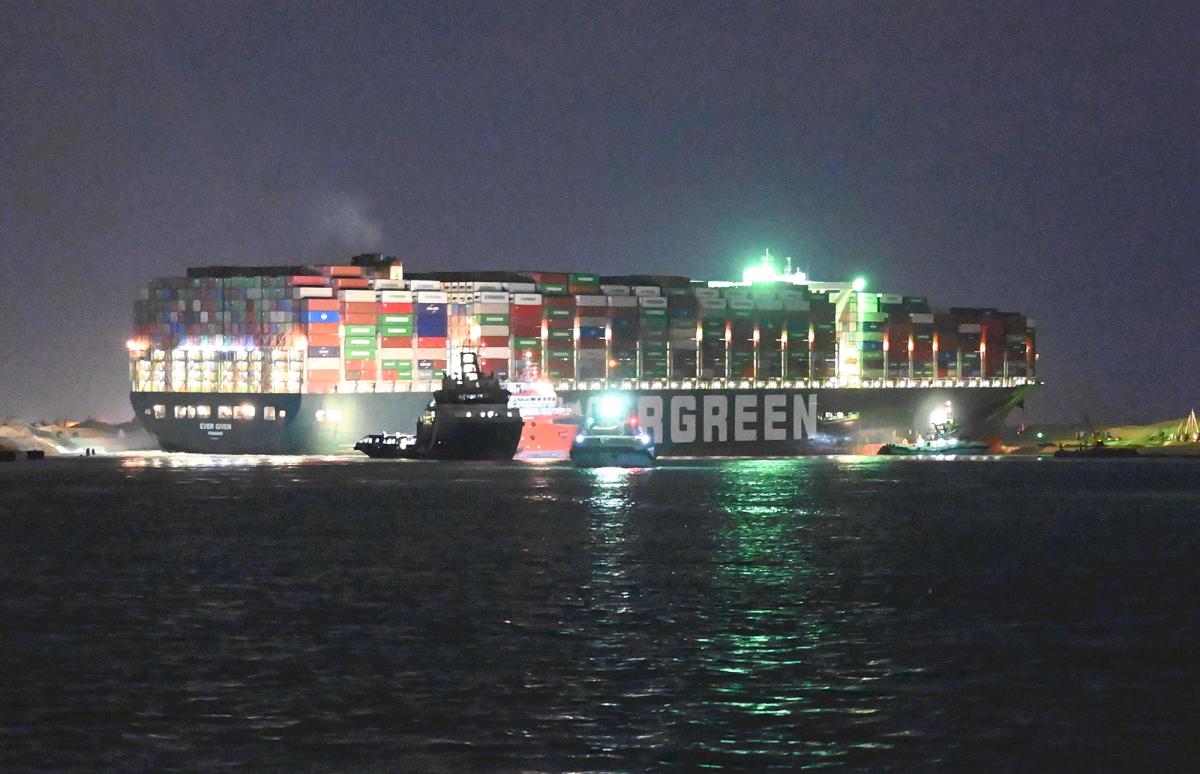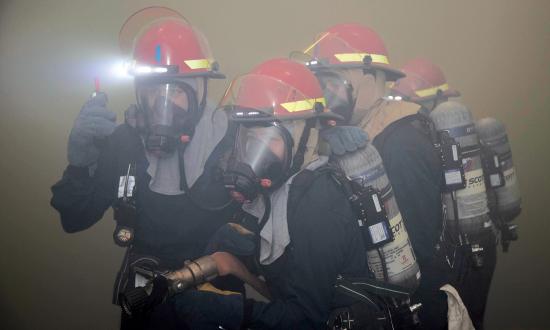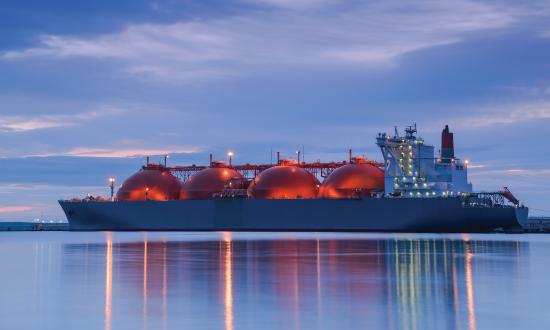Since its opening in November 1869, the Suez Canal has been a conduit for trade and military forces. It helped fuel the rise of the British Empire during the age of Imperialism and allowed its possessions in Asia to be drawn closer to the British Islands. During the World Wars, it was a target for attack, first by the Turks from the East, and then from the Germans and Italians from the West. In 1956, this symbol of imperialism was thrust into the world news when Egypt, led by Gamal Abdel Nasser, nationalized the canal, provoking a response from its original builders—Great Britain and France—and leading to the Suez Crisis. The canal remained closed until early 1957. Another conflict, this time the Six Day War of 1967, led to its blockage until 1975.
As ships were forced to sail via the southern tip of Africa—the Cape of Good Hope—the maritime industry responded by constructing vessels that emphasized an economy of scale. They grew in tonnage, particularly in the oil transportation sector. Over time, other types of large ships followed, and the Suez Canal had to expand to accommodate them. In 2015, following an $8 billion expansion that included a new double lane in the center section, new ships, such as the ultra-large container vessel (ULCV) MV Ever Given, a ship of 1,300 feet in length, a 200-foot beam, drawing nearly 50 feet of water and capable of carrying 20,000 containers, could traverse the canal.
On the morning of March 23, 2021, MV Ever Given was the fifth ship in the northern bound convoy departing the anchorage at Suez and beginning her passage through the canal from the Red Sea to the Mediterranean. The ship had completed a series of stops in China, Taiwan, and Malaysia and was scheduled to offload in Rotterdam, Felixstowe, and Hamburg at the start of April. She was one of eleven ships in the Golden class of containerships (the 13th largest class in the world) for the Taiwanese shipping company Evergreen. She reflects the international nature of world shipping. Her owner is Japanese, a German firm provides her crewing and maintenance, she is registered in Panama, and classified by an American agency. Her hull and machinery insurance are through Japan and her protection and indemnity insurance from Great Britain. As she entered the canal, she had an Indian crew onboard, along with two Egyptian Suez Canal Authority pilots.
That morning, at 0742 local time, Ever Given ran her bow into the eastern bank of the canal at 13 knots. The force with which she hit caused her stern to careen across the channel and push her rudder and propeller into the mud on the western bank. At a point in the canal only 200 meters across, Ever Given had her bow ashore in Asia, her stern planted on Africa, and her midships hanging across the navigable section of the canal, effectively cutting off twelve percent of the world’s trade in one swift action.
The cause of the grounding is mired in controversy. An early report by the ship’s agent and Panamanian registry identified a loss in power. There has been a rash of incidents worldwide, with vessels losing power caused by the adoption of new low Sulphur fuel mandated by IMO 2020 (though none previously reported in the Suez Canal). Ever Given’s operating company blamed the incident on strong wind gusts and a dust storm that pushed the vessel out of the channel. The Automatic Identification System (AIS) shows Ever Given meandering through the navigable channel prior to the vessel taking a hard turn to starboard and ramming the bank, grounding the forward third of the vessel.
The incident had an immediate impact. Astern of Ever Given, MV Maersk Denver, a U.S.- flagged containership and part of the 60-ship fleet of the U.S. Maritime Security Program, was forced to stop in less than a mile. The Maersk Lines, Limited ship was able to keep herself in the channel and avoid any damage, although the vessel astern, MV Asia Ruby III did suffer an engine malfunction that nearly sent her into the stern of the U.S. ship. Immediate attempts by the Egyptians to move the 200,000-ton containership proved unsuccessful. The scale and type of grounding required expert salvors.
eastern bank of the Suez Canal. (Associated Press)
SMIT, a subsidiary of Royal Boskalis Westminster, was called in by Evergreen’s insurers to oversee the salvage. With emergency response centers in Rotterdam, Houston, Cape Town, and Singapore, and a global presence, they are one of the leading salvors in the world. In 2016, they oversaw the refloating of CSCL Indian Ocean grounded in the Elbe River. The removal of Ever Given followed the model set in Germany five years earlier. Using dredgers from the Suez Canal Authority, SMIT directed the removal of spoil and bottom from the port bow and starboard quarter. Assessing the damage to the vessel, and with reports of leaks in the forepeak and bow thruster room, large pumps were brought on board to handle any further flooding when the vessel was freed. To assist in the removal, two large anchor tugs—ALP Guard and Carlo Magna—joined the effort to provide the necessary pull.
At approximately 04:30 on March 29, six days after her grounding, and after surveys indicated her rudder and propeller had been cleared from the bottom, her stern was freed from the west bank. With her aft end in the main channel, and her bow still aground, and no room to swing the vessel any further, the decision was made to use the ship’s engine and available tugs to expedite her removal before a full survey could be made of any damage caused by the shifting. This calculated risk was taken as the fleet of vessels waiting to transit the canal had grown to nearly 450.
That afternoon, at 15:00, with the spring high tide just starting to recede, Ever Given was pulled into the channel. In most cases, a vessel that had suffered such a grounding would have been towed clear of the canal, but within minutes she was underway on her own power. She sped up to 7 knots in less than an hour, heading to an anchorage in the Great Bitter Lake. As she entered the lake three hours later, ships that had been waiting to proceed into the Red Sea resumed their voyages. Ever Given was maneuvered into an anchorage near the eastern shore, close to shoal water should the need arise to beach the vessel, and to complete necessary repairs before her voyage could be completed.
The consequences of the unprecedented six-day disruption to carefully orchestrated global supply chains linking at least five continents are far reaching. Estimates put the hourly cost of the blockage at $400 million! While investigations likely will take many months—as is typical in events of this magnitude—some immediate outcomes of the logjam were apparent from the moment the bulbous bow of the ship rammed the canal sandbank.
To begin with, for a world community still in the grip of an obstinate pandemic, this maritime incident was an interesting distraction. Nagging thoughts about COVID-19 testing, new variants, and vaccine availability were replaced by daunting images of a steel leviathan, four football fields long and twenty stories high, and its effective blockade of the Suez Canal—which itself is a 152-year-old testimonial to human ingenuity.
People around the world Googled the canal, its history, and the geography of that part of the world, which many had either forgotten or ignored. Suddenly, those topics became ice breakers for many a virtual meeting. More importantly, an industry that rarely draws attention for anything it does right was suddenly in the headlines worldwide for a whole week, but with a marked difference. No oil was spilled; no one on board or in its immediate vicinity died from the incident; and the ship itself suffered minimal structural damage. As a result, the global community now has a better appreciation for container ships, their enormity, and their massive role in fulfilling our consumption needs. Some will forever retain a fascination for ships, the shipping milieu, and the box (standardized shipping containers) that changed the world.
The Ever Given incident vividly demonstrated how vulnerable today’s global supply chains are when their most critical link—the maritime workhorse, whether it be a container ship, an oil tanker, or a ship laden with bulk commodities—breaks down. The competitive dynamics within today’s global supply chains have fixated attention on cycle-time compression and on-time reliability rather than resilience within the system.
Although the Ever Given incident was unprecedented, it raises a number of questions. Given the size of ultra large container ships, the likelihood of strong wind gusts and sandstorms in the Suez region, and the razor-thin margin of error while on canal transit, were the potential adverse effects on an exposed, massive box-shaped superstructure and hydrodynamic bank suction effects analyzed by canal authorities and their naval architects? Why is a canal continuity of operations strategy not included in the playbook for any and all ships transiting the canal? Canal pilots in Suez work in an advisory capacity, but was their local knowledge shared with the ship’s master and watchkeepers? Was there negligence on the part of the ship’s crew? Did crew fatigue from the strains of operating a massive container ship in trouble-torn Red Sea waters along with COVID-19 ship operating protocols contribute to this? And what about mental health of seafarers, which has reportedly been on the decline since the pandemic began? Was it worsened because of unplanned (often involuntary) longer stays on board ships and the attendant separation from loved ones during uncertain times? These are just some of the questions that remain unanswered at this point.
Those of us who now look at the world of shipping and supply chains with new-found respect should dig a bit deeper to fathom how ships kept running, despite the pandemic, and delivered personal protective equipment and other essential goods. The story of how the global community of 1.7 million mariners toiled 24/7 to maintain a modicum of normalcy for the rest of us is an important one. Mostly overlooked when people think of “essential workers,” mariners subjected themselves to health and safety risks and yet received no particular priority for vaccination.
Finally, the Ever Given’s blockage of the Suez Canal provided a poignant lesson in globalization and its maritime nexus: some 20,000 cargo containers from a number of Asian countries, destined for countries in Europe and North America, carried by a Panamanian-flagged ship, built and owned by the Japanese, commercially operated by a Taiwanese shipping company, under German technical management, and fully crewed by Indian nationals! Wittingly or otherwise, as a verse from the ancient Sanskrit Upanishads puts it, “Vasudevaya Kudumbaka” (the world is one family).







